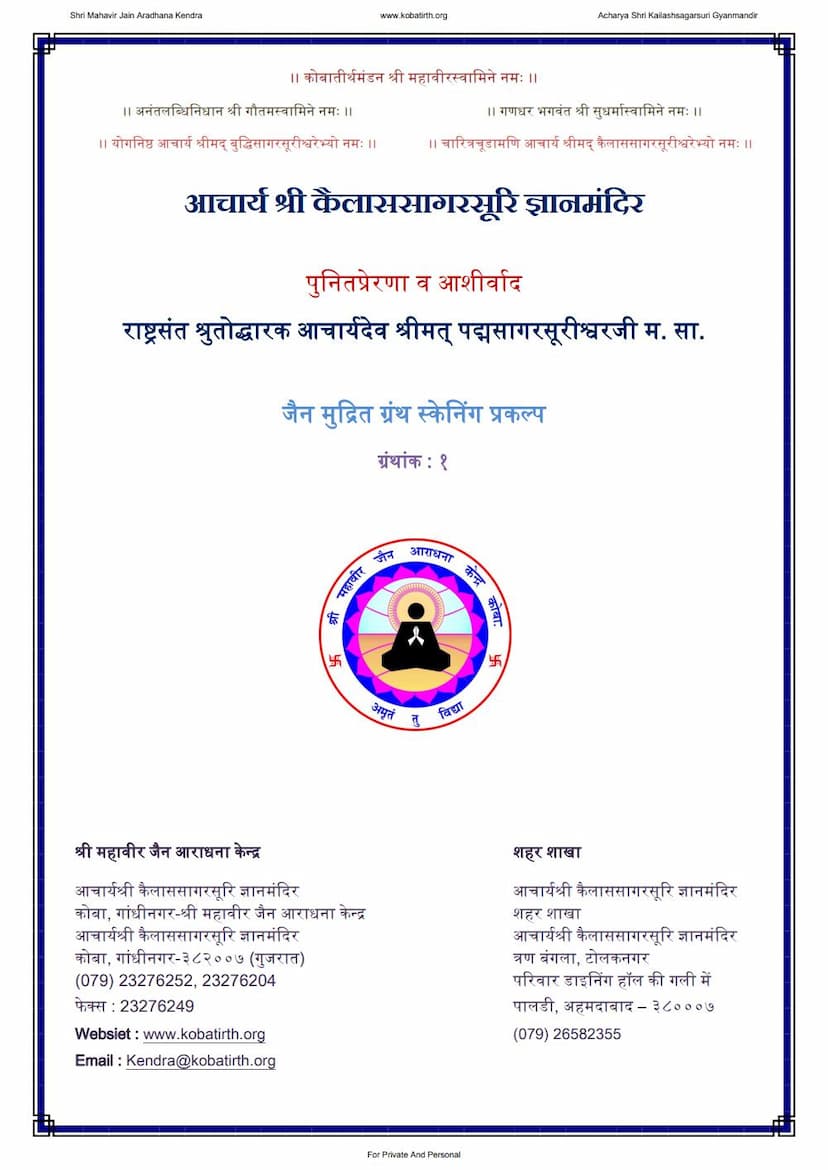Gautam Pruccha Vrutti
Added to library: September 1, 2025

Summary
The book "Gautam Pruccha Vrutti" by Shravak Hiralal Hansraj is a Jain text that presents a collection of questions and answers, primarily between Lord Mahavir and his chief disciple, Gautam Swami. The work is structured as a dialogue where Gautam Swami poses various questions to Lord Mahavir concerning the causes of different worldly conditions, suffering, virtues, and their results, primarily from a karmic perspective. Lord Mahavir, in turn, explains these through teachings and illustrative stories (katha).
Here's a comprehensive summary of the key themes and content, drawing from the provided pages:
Core Purpose: The primary aim of the book is to educate and guide lay followers (Shravaks) by explaining the principles of Jainism, particularly the law of karma, in a clear and accessible manner. It aims to dispel ignorance and promote right understanding (Samyak Darshan) and conduct.
Key Themes and Questions Explored:
The text delves into a wide range of questions, illustrating the intricate workings of karma and the consequences of actions (karma phala). Some of the recurring themes and question types include:
- Rebirth and Transformations: Why does the soul transmigrate into different forms of existence (hellish beings, animals, humans, celestial beings)? What actions lead to rebirth in specific realms? How do actions influence one's gender, lifespan, physical attributes, and social status in future lives?
- Causes of Suffering and Afflictions: The text extensively explores the karmic roots of various human ailments and misfortunes, such as:
- Blindness, deafness, muteness, lameness, and physical deformities.
- Poverty and immense wealth.
- Disease and health.
- Intelligence and ignorance.
- Suffering in relationships (e.g., childlessness, loss of children).
- Untimely death.
- Virtues and Their Rewards: Conversely, the book highlights the positive karmic consequences of virtuous actions, including:
- Generosity (Daan).
- Discipline and righteousness (Samyam, Charitra).
- Devotion to the Tirthankaras, Gurus, and the path of righteousness (Bhakti, Vinay).
- Compassion and non-violence (Dayā, Ahinsā).
- Truthfulness and sincerity.
- Contentment.
- Moral and Ethical Conduct: The teachings emphasize the importance of ethical behavior, such as:
- Avoiding falsehoods, anger, greed, attachment, and malice.
- Respecting elders, teachers, and the righteous.
- The dangers of slander, deception, and breaking vows.
- Spiritual Liberation (Moksha): The ultimate goal of Jainism, Moksha, is presented as the cessation of karmic bondage and the attainment of eternal bliss, achievable through right faith, knowledge, and conduct.
Illustrative Stories (Kathas):
A significant portion of the book consists of detailed narratives that exemplify the karmic principles being discussed. These stories often involve:
- Past Lives: The characters in the stories are often shown experiencing the fruits of actions performed in their previous births, tracing the karmic consequences across multiple lifetimes.
- Examples of Virtuous Individuals: Stories of individuals who adhered to Jain principles, even in adverse circumstances, are presented as role models.
- Examples of Negative Consequences: Conversely, narratives of those who indulged in harmful actions and faced dire repercussions in this or future lives serve as cautionary tales.
- Divine Intervention and Tests: Sometimes, celestial beings or deities play a role in testing individuals or in the unfolding of karmic justice.
Specific Examples and Concepts Mentioned (based on pages provided):
- Gautam Swami's Role: Gautam Swami, the chief disciple, diligently poses questions to Lord Mahavir, acting as a representative of humanity seeking understanding.
- Lord Mahavir's Authority: Lord Mahavir's responses are presented as authoritative and definitive, stemming from his omniscience.
- The Nature of the Soul (Jiva): The soul is depicted as eternal and the transmigration of the soul is central to the explanations.
- The Power of Knowledge and Conduct: The text consistently emphasizes that true happiness and liberation come from cultivating right knowledge (Jnana) and right conduct (Charitra).
- The Impact of Past Actions: The book repeatedly stresses that one's present circumstances are a direct result of past karmic deeds.
- The Importance of Renunciation and Detachment: Stories often highlight the benefits of renouncing worldly pleasures and attachments to pursue spiritual goals.
- The Role of Faith: Strong faith in the Tirthankaras and their teachings is presented as a crucial factor in spiritual progress.
Methodology:
The book uses a question-and-answer format, often starting with a "Gatha" (a verse in Prakrit or Apabhramsa) followed by its explanation in Sanskrit or a vernacular language. The stories are then presented to illustrate the meaning of the Gatha and the underlying principle.
Overall Tone and Message:
The "Gautam Pruccha Vrutti" conveys a profound message of personal responsibility for one's actions and their consequences. It encourages a life of virtue, discipline, and devotion as the path to overcoming suffering and attaining spiritual liberation, aligning with the core tenets of Jain philosophy. The detailed question-and-answer format makes complex philosophical concepts more accessible to a wider audience.